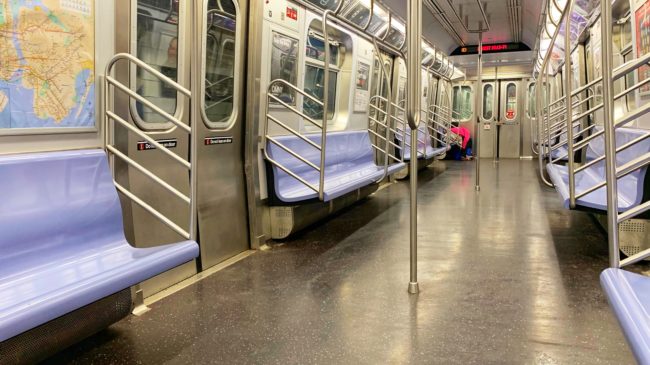A new report from Riders Alliance, a transit advocacy group, suggests that the New York Metropolitan Transit Authority (MTA) would have to cut 12 New York subway lines “without the $3.9 billion it needs” in additional federal stimulus to help it deal with drops in revenue and the coronavirus pandemic.
The Coronavirus Aid, Relief, and Economic Security Act, or CARES Act, contained $25 billion in aid for mass transit systems, including $3.9 billion for MTA, to supplement the existing federal operating subsidies these systems receive.
According to the Riders Alliance, the MTA has already used that funding and would face a budget shortfall approaching 50 percent if it does not immediately receive an additional $3.9 billion in stimulus from federal taxpayers. Without that additional federal aid, they say, MTA would soon have to make major cuts.
The Riders Alliance report mentions three cost reduction strategies. The most detailed of their proposals is a dire warning that MTA would eliminate several lines entirely, including the 6th Avenue (“B”, “D”, “F”), 7th Avenue (“1”, “2”, ”3”), Flushing (“7”) and Metropolitan Avenue (“M”) subways lines, among others. They warn:
With these line closures, 163 of the system’s 424 stations would shut down indefinitely. While the instantly recognizable subway map would be utterly transformed, so too would the borough bus maps and commuter rail lines, each of which would also be subject to a 50% reduction in capacity.
Areas with subway access would be inundated with additional car traffic that transit cuts would invite. Additional driving would create more traffic congestion, delays in emergency response times, particulate pollution that aggravates respiratory illnesses like asthma and COVID-19, and deadly and injurious collisions between vehicles and pedestrians and cyclists.
Aside from this especially lurid scenario, the Riders Alliance offers two other alternatives: (1) maintain all lines but eliminate all express service and reduce frequencies and (2) maintain subway service as-is, but eliminate bus and commuter rail services.
Unfortunately for policymakers reviewing the report, none of the three proposed scenarios have been optimized to provide the best possible service to riders given MTA’s reduced resources and current commuting and travel patterns. The three scenarios are unrepresentative of what a reasonable MTA service plan intended to best serve riders might look like.
To get an accurate picture of current affairs, schedule planners need to carefully assess ridership patterns across all MTA services as New Yorkers return to work after the long coronavirus shutdown. After such analysis of current travel patterns and near-term projections, service cuts would most likely be balanced across subways, buses, and commuter rail without any of these services suffering the worst-case shut downs posited by the Riders Alliance.
An alternative scenario could involve eliminating just the most lightly traveled lines, reducing or eliminating service on routes that have convenient alternates, and reducing frequencies on most other lines—versus pre-pandemic levels—until ridership on lines fully returns.
For example, several stations in Rockaway were serving fewer than 1,000 riders daily back in 2018. For now, or until ridership recovers to its pre-COVID levels, it might make sense to terminate A line service at Howard Beach and encourage passengers to use buses, ride-sharing services (with both drivers and passengers masked throughout the trip) or their own vehicles to traverse the last few miles to and from the Rockaway peninsula.
Planners could also consider a variety of other options, like eliminating the Times Square to Grand Central shuttle—a line that is less than 0.5 miles long and parallels the Number 7 Flushing Line as well as 42nd Street Crosstown bus service. Eliminating the Staten Island Railway, which had an estimated $84 million in expenses and only $7 million in farebox revenue in 2019, offers potential cost-savings.
Likewise, running fewer trains per hour while overall ridership is depressed also makes sense for now. Transit service levels should be adjusted to reflect changes in commutes and travel and to prevent overcrowding as more people return to using them. The Riders Alliance warns that transit crowding “would greatly increase the risk of another wave of COVID-19,” which is some commuters are likely to continue to rely on personal automobiles, biking and rideshare options when feasible and affordable for them.
MTA may also consider that reduced frequency subway and bus service could be more palatable to riders if MTA follows a strict schedule, as commuter rail lines currently do. By adhering to schedules and providing travelers with app-based notifications of subway/bus positions and estimated arrival times, the MTA may be able to make service more reliable and reduce the amount of time most passengers have to wait in subway stations and at bus stops.
Transit advocates, such as the Riders Alliance, are right that MTA will have to adapt to its new budget situation as the nation continues to deal with the coronavirus pandemic. But in making changes to service to reflect current and short-term ridership patterns, New York City’s transit agency has the ability to be much more creative and innovative than the dire report suggests. Good public policy requires serious cost/benefit analysis to find the most effective use of available transportation funds.

